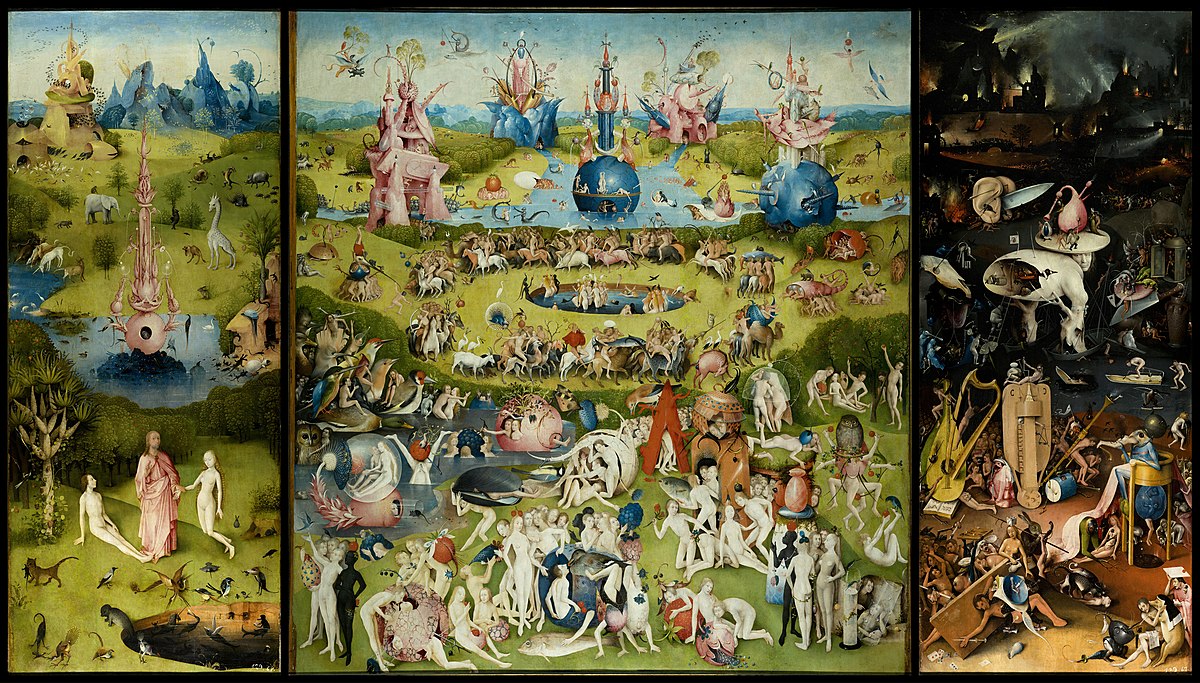

Articles
Who Painted The Garden Of Earthly Delights
Modified: January 6, 2024
Discover the enigmatic artist behind "The Garden of Earthly Delights" and delve into the world of gardening in this intriguing exploration. Uncover the secrets of this iconic masterpiece and gain insights into the art of gardening.
(Many of the links in this article redirect to a specific reviewed product. Your purchase of these products through affiliate links helps to generate commission for Storables.com, at no extra cost. Learn more)
Introduction
Welcome to the enigmatic world of Hieronymus Bosch and his masterpiece, The Garden of Earthly Delights. This timeless artwork has captivated art enthusiasts, historians, and curious minds for centuries, inviting them to unravel its intricate symbolism and mysterious origins. In this article, we will embark on a captivating journey through the vivid imagery and profound symbolism of The Garden of Earthly Delights, while delving into the fascinating life of the artist behind this iconic creation. Prepare to be immersed in a world where art, history, and speculation intertwine to form a tapestry of intrigue and wonder.
Key Takeaways:
- Hieronymus Bosch, the mysterious artist behind The Garden of Earthly Delights, used surreal imagery and hidden symbolism to create a timeless masterpiece that continues to captivate and intrigue audiences worldwide.
- The triptych’s juxtaposition of paradise, earthly indulgence, and infernal punishment serves as a powerful allegory for human experience, morality, and the consequences of temptation and sin, inviting viewers to contemplate its profound messages.
Read more: Gifts For Gardeners Who Have Everything
Hieronymus Bosch: The Enigmatic Artist
Hieronymus Bosch, a Dutch painter born Jheronimus van Aken, remains one of the most mysterious and celebrated artists of the Northern Renaissance. His life, shrouded in the mists of time, has become the subject of fascination and speculation. Bosch’s birth year is estimated to be around 1450 in the town of ‘s-Hertogenbosch, from which he derived his name. Little is known about his personal life, adding an air of enigma to his artistic legacy.
Bosch’s works are characterized by their fantastical and often macabre imagery, depicting intricate scenes that blur the lines between reality and the surreal. His unique style and imaginative compositions have earned him a revered place in the art world, with The Garden of Earthly Delights standing as a testament to his unparalleled creativity.
While Bosch’s artistic vision was undoubtedly ahead of its time, the true motivations and inspirations behind his work continue to elude scholars and art enthusiasts. Some speculate that his paintings were influenced by the religious and moralistic fervor of the time, while others suggest that Bosch may have been influenced by alchemical and esoteric beliefs, infusing his art with layers of hidden meanings and symbolism.
Despite the mysteries surrounding Bosch’s life and motivations, his impact on the art world is undeniable. His ability to evoke profound emotions and provoke contemplation through his art has solidified his reputation as a visionary artist whose work transcends the constraints of time and convention.
The Garden of Earthly Delights: An Overview
The Garden of Earthly Delights is a triptych masterpiece created by Hieronymus Bosch, comprising three panels that unfold a mesmerizing narrative across the canvas. The left panel depicts the Garden of Eden, with its serene and idyllic landscape inhabited by Adam and Eve, surrounded by diverse flora and fauna. In stark contrast, the central panel presents a surreal and extravagant panorama teeming with human figures engaged in a myriad of activities, set within a fantastical landscape. The right panel unveils a haunting and desolate vision of hell, replete with grotesque and nightmarish imagery.
Bosch’s meticulous attention to detail and his ability to seamlessly blend the real and the surreal imbue The Garden of Earthly Delights with an otherworldly allure. The central panel, in particular, has been the subject of extensive analysis and interpretation, with its enigmatic scenes inviting viewers to ponder the intricate symbolism and allegorical meanings embedded within the composition.
The juxtaposition of paradise, earthly indulgence, and infernal punishment within the triptych serves as a powerful allegory for the human experience, morality, and the consequences of temptation and sin. The rich symbolism and the intricate interplay of light and shadow in Bosch’s masterpiece continue to ignite the imagination of art enthusiasts and scholars, prompting ongoing exploration and contemplation of its profound messages.
Through its mesmerizing imagery and thought-provoking symbolism, The Garden of Earthly Delights stands as a testament to Bosch’s unparalleled artistic vision and his ability to transcend the boundaries of conventional representation. Each panel of the triptych unfolds a captivating narrative that transcends time, inviting viewers to immerse themselves in the rich tapestry of Bosch’s enigmatic masterpiece.
The Garden of Earthly Delights was painted by the Dutch artist Hieronymus Bosch in the early 16th century.
Theories and Speculations on the Artist
The enigmatic nature of Hieronymus Bosch and his masterpiece, The Garden of Earthly Delights, has sparked a plethora of theories and speculations regarding the artist’s inspirations, motivations, and the symbolic meanings embedded within his work. Bosch’s intricate and often perplexing imagery has led to a wealth of interpretations, with scholars and art enthusiasts endeavoring to unravel the mysteries concealed within his paintings.
One prevailing theory suggests that Bosch’s art was deeply influenced by the religious and moralistic fervor of his time. The vivid depictions of sin, temptation, and divine retribution in The Garden of Earthly Delights are seen as a reflection of the prevailing religious doctrines and the societal emphasis on morality and salvation. Bosch’s surreal and often nightmarish imagery is believed to serve as a cautionary allegory, urging viewers to contemplate the consequences of earthly indulgence and the pursuit of sinful desires.
Another intriguing speculation revolves around the notion that Bosch may have been influenced by alchemical and esoteric beliefs, infusing his art with layers of hidden meanings and symbolism. The intricate details and cryptic symbolism found within The Garden of Earthly Delights have led some to interpret the triptych as an esoteric allegory, delving into the realms of alchemical transformation and spiritual enlightenment.
Furthermore, Bosch’s artistic vision has been linked to the cultural and intellectual currents of the Renaissance, with some scholars positing that his work reflects the era’s fascination with the human experience, the natural world, and the interplay between the earthly and the divine. The fantastical landscapes and the diverse array of figures populating Bosch’s compositions have been interpreted as a reflection of the Renaissance fascination with humanism, exploration, and the pursuit of knowledge.
Despite the myriad of theories and speculations, the true motivations and inspirations behind Bosch’s art remain a subject of ongoing debate and fascination. The enduring allure of The Garden of Earthly Delights lies in its ability to invite contemplation, interpretation, and a sense of wonder, transcending the confines of time and cultural context.
Conclusion
As we conclude our exploration of Hieronymus Bosch and his iconic masterpiece, The Garden of Earthly Delights, we are left with a profound sense of awe and wonder at the enigmatic legacy of this visionary artist. Bosch’s ability to weave intricate symbolism, surreal imagery, and profound allegory into his paintings has ensured his enduring impact on the art world and the human imagination.
The Garden of Earthly Delights continues to captivate audiences with its mesmerizing narrative, inviting viewers to embark on a journey through the realms of paradise, earthly indulgence, and infernal retribution. The triptych stands as a testament to Bosch’s unparalleled creativity and his ability to transcend the boundaries of conventional representation, delving into the depths of the human experience and moral contemplation.
Through the centuries, Bosch’s art has sparked a myriad of theories and speculations, reflecting the enduring fascination with the mysteries concealed within his works. Whether influenced by religious fervor, alchemical symbolism, or the intellectual currents of the Renaissance, Bosch’s art remains a rich tapestry of interpretation, inviting contemplation and exploration.
As we gaze upon The Garden of Earthly Delights, we are reminded of the timeless power of art to provoke contemplation, evoke emotion, and transcend the constraints of time and culture. Hieronymus Bosch’s enigmatic masterpiece continues to inspire, intrigue, and ignite the imagination, inviting us to delve into its depths and unravel the profound mysteries that lie within.
In the end, The Garden of Earthly Delights stands as a testament to the enduring allure of art and the boundless creativity of the human spirit, inviting us to ponder the complexities of existence and the enigmatic visions of one of history’s most enigmatic artists.
Frequently Asked Questions about Who Painted The Garden Of Earthly Delights
Was this page helpful?
At Storables.com, we guarantee accurate and reliable information. Our content, validated by Expert Board Contributors, is crafted following stringent Editorial Policies. We're committed to providing you with well-researched, expert-backed insights for all your informational needs.
















0 thoughts on “Who Painted The Garden Of Earthly Delights”